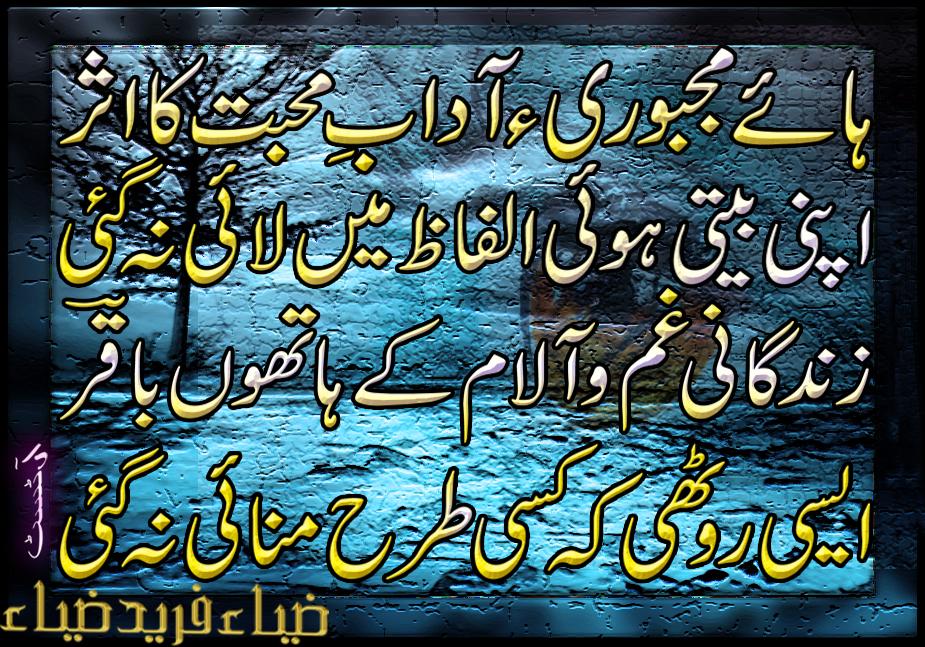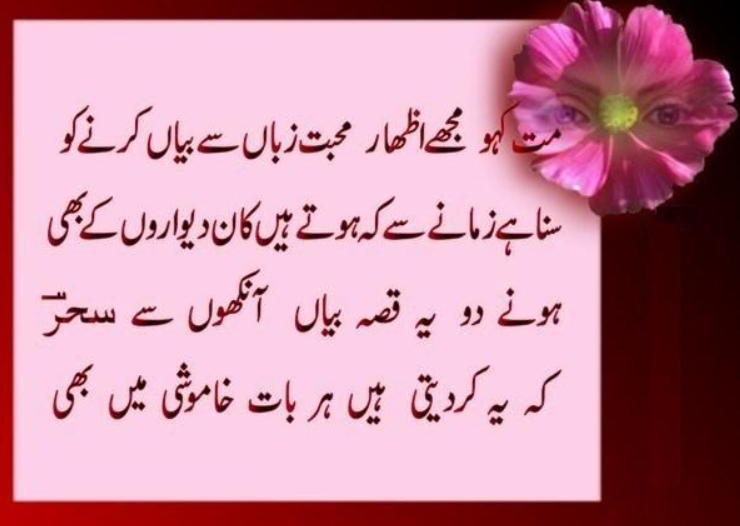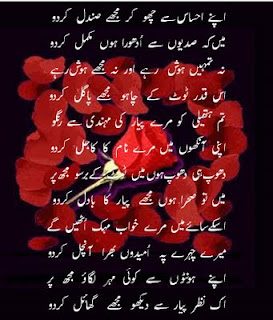Urdu Love Poetry Biography
Source:- Google.com.pk
Poetry is a personal and emotional genre making it difficult to truly
explain what constitutes poetry; however, we can summarize it in the
following definitions of poetry:
• The expression of the heart, human experience, feelings and thoughts.
• Expressing facts in appropriate words.
• A description of life written with imagination and emotion.
• The most popular genre of literature.
• The fountain to civilization, constitution and different arts and crafts.
• The concoction of all knowledge and craft. q An element of surprise to us.
• An art through which a poet can excite the emotions and feelings of others.
• Expressing an ordinary event in an effective, heart-stealing style of
writing that creates a sharp reaction in the heart and mind of the
reader.
Poetry is universal as every language spoken by mankind has in it some
poetic elements. Interestingly, though languages differ significantly in
the manner of expression, the nature of poetic expression remains
common indicating that poetry is more of a human phenomenon rather than
syntactical expression. From expression of love for a woman to revolt
against a regime, poetry carries in it an element of subtlety and
spontaneity—something created by the environs of the poet. To understand
a great poet, therefore, we must first look into his mind and his
awareness of the milieu exterior. Since Ghalib, undoubtedly the greatest
poet of Urdu language, expressed himself mainly through his writings of
love sonnets, it is imperative that we examine the art of love sonnets,
the language they are written in, and the environs that prompted these
writings to understand how Ghalib became a master of this genre.
In this chapter we will examine the roots of Urdu language, Urdu poetry
and particularly the genre of love sonnets, ghazals, in Urdu. The
following chapter will examine the life and works of Ghalib and the
third chapter will offer a broad view of Ghalib’s art of expression in
love sonnets, the ghazals.
Urdu, literally meaning “camp” in Turkish, is a mixture of many tongues
and languages. Muslims brought many different languages to India, and
diluted India’s languages freely with words from their own. When Delhi
was the seat of the Muslim Empire in the late 12th century, the
languages around Delhi, mainly Brij Bhasha and Sauraseni became heavily
mixed with Persian, the lingua franca of the Muslim rulers. Other
languages that found their way into the languages of India were Turkish,
Arabic and later English. Whereas much of the vocabulary of the
original languages (Sauraseni, for example) changed, the basic grammar
structure remained intact. In the 13th century, the language of India
became widely known as Hindvi, Hindi, and Brij Bhasha and was written in
the original devanagri script [the Sanskrit script]. The name gUrdug
was given to this thriving language of the region in the period of the
Mughal Emperor Shah Jehan (1627-1658). The language was introduced to
the southern province of India, Hyderabad Deccan, by the armies and
followers of the Tughlaq and Khilji kings in the 14th century. Affected
by the dialects of the South, the language became known as Deccani
(after Hyderabad Deccan), having adopted the Persian script and replaced
Persian in offices as the official language. Since the language was
written in the devanagri script for quite some time around Delhi, it had
been erroneously assumed that the first Urdu poet was Amir Khusro
(1253-1325) from the Deccan. The fact is many poets up in the North had
already been writing Urdu poetry, namely Kabir Das, Mira Bai, Guru
Nanak, Malik Mohammad Jaisi and Abdul Rahim Khan Khanan, who lived much
earlier than Amir Khusro.Urdu poetry of the Indian subcontinent as we
know it today did not take its final shape until the 17th century when
it was declared the official language of the court. The 18th century saw
a phenomenal rise in Urdu poetry when Urdu replaced Persian as the
lingua franca of the region. Urdu poetry, as it is derived from Persian,
Turkish and Arabic, acquired many conventions in its poetry that came
from these languages. Just as Elizabethan English is full of social and
regional realities, Urdu holds a remarkable wealth of the conventions of
many cultures and languages. This element got a great boost in the 18th
century when there weren’t many newspapers or media of information
available to the public. Urdu poetry became a more intimate form of
communication regarding the social and political tribulations of the
time. The commonest form of communication.
Urdu Love Poetry Urdu Poetry Sms Sad Love Pic Wallpaper Ahmed Faraz Wasi Shah Romantic Photos Pics Urdu Love Poetry Urdu Poetry Sms Sad Love Pic Wallpaper Ahmed Faraz Wasi Shah Romantic Photos Pics
Urdu Love Poetry Urdu Poetry Sms Sad Love Pic Wallpaper Ahmed Faraz Wasi Shah Romantic Photos Pics  Urdu Love Poetry Urdu Poetry Sms Sad Love Pic Wallpaper Ahmed Faraz Wasi Shah Romantic Photos Pics
Urdu Love Poetry Urdu Poetry Sms Sad Love Pic Wallpaper Ahmed Faraz Wasi Shah Romantic Photos Pics  Urdu Love Poetry Urdu Poetry Sms Sad Love Pic Wallpaper Ahmed Faraz Wasi Shah Romantic Photos Pics
Urdu Love Poetry Urdu Poetry Sms Sad Love Pic Wallpaper Ahmed Faraz Wasi Shah Romantic Photos Pics  Urdu Love Poetry Urdu Poetry Sms Sad Love Pic Wallpaper Ahmed Faraz Wasi Shah Romantic Photos Pics
Urdu Love Poetry Urdu Poetry Sms Sad Love Pic Wallpaper Ahmed Faraz Wasi Shah Romantic Photos Pics  Urdu Love Poetry Urdu Poetry Sms Sad Love Pic Wallpaper Ahmed Faraz Wasi Shah Romantic Photos Pics
Urdu Love Poetry Urdu Poetry Sms Sad Love Pic Wallpaper Ahmed Faraz Wasi Shah Romantic Photos Pics  Urdu Love Poetry Urdu Poetry Sms Sad Love Pic Wallpaper Ahmed Faraz Wasi Shah Romantic Photos Pics
Urdu Love Poetry Urdu Poetry Sms Sad Love Pic Wallpaper Ahmed Faraz Wasi Shah Romantic Photos Pics Urdu Love Poetry Urdu Poetry Sms Sad Love Pic Wallpaper Ahmed Faraz Wasi Shah Romantic Photos Pics
Urdu Love Poetry Urdu Poetry Sms Sad Love Pic Wallpaper Ahmed Faraz Wasi Shah Romantic Photos Pics  Urdu Love Poetry Urdu Poetry Sms Sad Love Pic Wallpaper Ahmed Faraz Wasi Shah Romantic Photos Pics
Urdu Love Poetry Urdu Poetry Sms Sad Love Pic Wallpaper Ahmed Faraz Wasi Shah Romantic Photos Pics  Urdu Love Poetry Urdu Poetry Sms Sad Love Pic Wallpaper Ahmed Faraz Wasi Shah Romantic Photos Pics
Urdu Love Poetry Urdu Poetry Sms Sad Love Pic Wallpaper Ahmed Faraz Wasi Shah Romantic Photos Pics  Urdu Love Poetry Urdu Poetry Sms Sad Love Pic Wallpaper Ahmed Faraz Wasi Shah Romantic Photos Pics
Urdu Love Poetry Urdu Poetry Sms Sad Love Pic Wallpaper Ahmed Faraz Wasi Shah Romantic Photos Pics
 Urdu Love Poetry Urdu Poetry Sms Sad Love Pic Wallpaper Ahmed Faraz Wasi Shah Romantic Photos Pics
Urdu Love Poetry Urdu Poetry Sms Sad Love Pic Wallpaper Ahmed Faraz Wasi Shah Romantic Photos Pics  Urdu Love Poetry Urdu Poetry Sms Sad Love Pic Wallpaper Ahmed Faraz Wasi Shah Romantic Photos Pics
Urdu Love Poetry Urdu Poetry Sms Sad Love Pic Wallpaper Ahmed Faraz Wasi Shah Romantic Photos Pics  Urdu Love Poetry Urdu Poetry Sms Sad Love Pic Wallpaper Ahmed Faraz Wasi Shah Romantic Photos Pics
Urdu Love Poetry Urdu Poetry Sms Sad Love Pic Wallpaper Ahmed Faraz Wasi Shah Romantic Photos Pics  Urdu Love Poetry Urdu Poetry Sms Sad Love Pic Wallpaper Ahmed Faraz Wasi Shah Romantic Photos Pics
Urdu Love Poetry Urdu Poetry Sms Sad Love Pic Wallpaper Ahmed Faraz Wasi Shah Romantic Photos Pics  Urdu Love Poetry Urdu Poetry Sms Sad Love Pic Wallpaper Ahmed Faraz Wasi Shah Romantic Photos Pics
Urdu Love Poetry Urdu Poetry Sms Sad Love Pic Wallpaper Ahmed Faraz Wasi Shah Romantic Photos Pics  Urdu Love Poetry Urdu Poetry Sms Sad Love Pic Wallpaper Ahmed Faraz Wasi Shah Romantic Photos Pics
Urdu Love Poetry Urdu Poetry Sms Sad Love Pic Wallpaper Ahmed Faraz Wasi Shah Romantic Photos Pics Urdu Love Poetry Urdu Poetry Sms Sad Love Pic Wallpaper Ahmed Faraz Wasi Shah Romantic Photos Pics
Urdu Love Poetry Urdu Poetry Sms Sad Love Pic Wallpaper Ahmed Faraz Wasi Shah Romantic Photos Pics  Urdu Love Poetry Urdu Poetry Sms Sad Love Pic Wallpaper Ahmed Faraz Wasi Shah Romantic Photos Pics
Urdu Love Poetry Urdu Poetry Sms Sad Love Pic Wallpaper Ahmed Faraz Wasi Shah Romantic Photos Pics  Urdu Love Poetry Urdu Poetry Sms Sad Love Pic Wallpaper Ahmed Faraz Wasi Shah Romantic Photos Pics
Urdu Love Poetry Urdu Poetry Sms Sad Love Pic Wallpaper Ahmed Faraz Wasi Shah Romantic Photos Pics
No comments:
Post a Comment